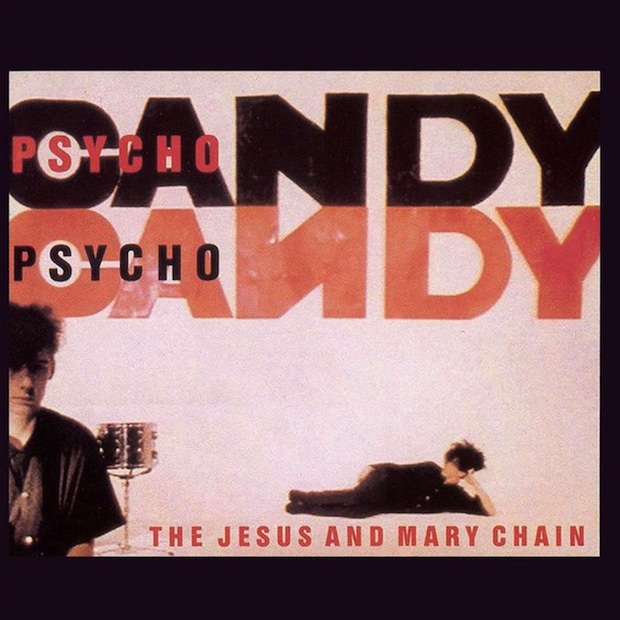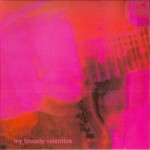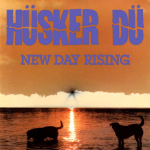The Jesus and Mary Chain : Psychocandy

Inspired by acts as diverse as the Velvet Underground, the late ’60s girl group The Shangri-Las and Phil Spector’s sonic walls of sound, Scottish-born brothers William and Jim Reid (the core duo behind The Jesus and Mary Chain) blended anarchic feedback with pretty, fledgling shoegaze on their debut album, appropriately named Psychocandy. The title perfectly captures the sugary hooks, the semi-goth gloom and the shrieking guitars that epitomize The Jesus and Mary Chain’s trademark brand of noise pop. On their debut, an album that would inspire acts such as The Boo Radleys, The Pixies and The Black Rebel Motorcycle Club, both Reids melded simple melodies with guitar-driven mayhem that plods or sprints along to a three-string bassline by school friend Douglas Hart and a drum machine-like beat supplied by two-drum Bobby Gillespie, frontman for Primal Scream.
Listening to Psychocandy is like listening to a recording of “Be My Baby” played at full blast down the hall, a microphone in a trash can capturing the echoes and fuzz. All the while, one of the Reids drones out the lyrics, some of them evocative and sexual (e.g., “Just Like Honey”), some of them hipper than thou as it postures and adjusts its disheveled hair (e.g., “The Living End,” “Never Understand”), all of them undeniably refreshing and cool. Yet years of playing shows—their first one ending with the band smashing the venue’s P.A.—helped refine The Jesus and Mary Chain’s musicianship leading up to the release of Psychocandy. While it may seem like a blast of noise tenuously tethered to a melody, the album was, in reality, meticulously mixed and remixed to get the sound just right.
The album opens with “Just Like Honey,” one of three singles the band released prior to Psychocandy and one of three variations of fuzzy noise that are found on the album. The song features the Spector drums that appear in other tracks on the album, such as the Velvet Underground-sounding “Cut Dead” and “Sowing Seeds.” The lyrics on “Just Like Honey” are provocative, to say the least. Lines about a girl’s “honey dripping beehive” probably don’t refer to her hairdo, nor does the line about being someone’s plastic toy seem so innocent. Regardless, the song is so fawning and sincere that it’s more a love song than a tale of carnal, scum-eating raunch. “Just Like Honey” helped close out Sofia Coppola’s brief encounter yarn Lost in Translation, the soundtrack also featuring “Sometimes” by fellow shoegazers My Bloody Valentine.
The slower songs are a stark contrast to the more abrasive side of The Jesus and Mary Chain, another distinct brand of noise on Psychocandy. This shoegazer leaning follows “Just Like Honey” in the rebellious biker guise of “The Living End.” It’s a song reminiscent of Hüsker Dü but clad in black leather while making a wide-legged stance as the narrator readies himself for a snarling motobike ride to nowhere. The high-pitched overdrive of “In a Hole” also exemplifies this more abrasive side. If it weren’t for the sedate vocals, the song could be cited as an early ancestor of industrial music. Indeed, the youthful rebellion on “Never Understand” could have been classified as industrial as well if it weren’t for the flippant quality evoked by the catchy vocal melody or the lyrics expressing teenage-or-twentysomething angst.
The third brand of noise is found on the band’s mid-tempo pop songs, found on tracks such as “The Hardest Walk,” “Taste of Cindy” or “My Little Underground.” Each of the previously mentioned songs is a fuzzy pop gem on their own, the first dealing with a break up, the second with obsession over the eponymous girl in the song and the third about escaping to isolate oneself from the world. These three-chord or four-chord songs are the ones that are easiest to latch on to and often the catchiest offerings on the album, particularly “My Little Underground” with its sing along chorus that concludes with some well-placed “uh-oh-ohs.”
Even the penultimate mid-tempo ditty, “Something’s Wrong,” as sad and a gloomy and—frighteningly enough—personally relevant as it may be, sounds gorgeous. If you lose yourself in the fuzz, you miss the bittersweet lyrics about an important moment of self-realization. On said song, the narrator wonders where his life has been going the last two years and has finally noticed that something is wrong and has got to be changed. As the last round of fuzz pours over the song, it comes down like a warm and sympathetic rain.
Psychocandy sets up what would be a fine run by the Brothers Reid until the eventual meltdown of The Jesus and Mary Chain in Los Angeles in 1998 and the eventual official break up the following year (succeeded, years later, by an inevitable reunion). While the album can’t come close to seeing one of those mythic, early Jesus and Mary Chain shows—the band’s collective back turned to the audience; the audience, sparse as it may be, washed over with glorious noise—Psychocandy does have the right attitude to evoke images of smoky pubs and riotous youth, all of whom are all so cool, all so misunderstood and maybe a few all too aware of being in the presence of greatness.
Label: Blanco y Negro
Year: 1985
Similar Albums:
 My Bloody Valentine – Loveless
My Bloody Valentine – Loveless
 Hüsker Dü – New Day Rising
Hüsker Dü – New Day Rising
 Velvet Underground – White Light/White Heat
Velvet Underground – White Light/White Heat

